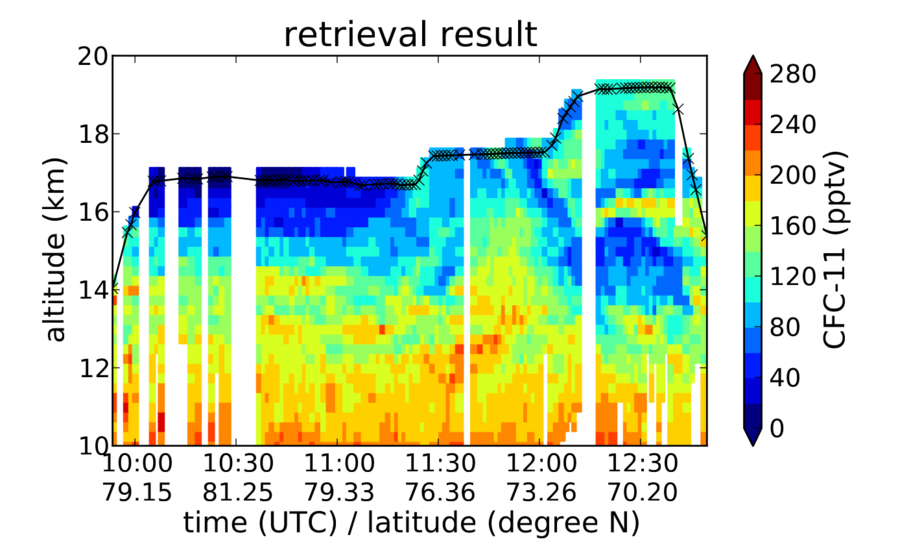CRISTA-NF - a Helium-cooled Infrared Telescope for the Atmosphere
Trace gas retrieval
The CRISTA-NF measurements are mainly used to derive two-dimensional information on several trace gases. The derivation of volume mixing ratios (VMR) using radiance measurements of the instrument is called retrieval. In the case of CRISTA-NF we use the retrieval software JURASSIC (JUelich RApid Spectral SImulation Code LINK), which was developed at the Research Center Jülich. The dense vertical sampling during the measurements made it possible to reach an unprecedented vertical resolution of the retrieval results of about 400 – 500 m for several trace gases (e.g. CFC-11, HNO3, ClONO2, and ozone) for several kilometers below flight altitude. More information on the retrieval technique and the validation of the results are given in Ungermann et al. (2012) (LINK).
The high vertical resolution enables the observation of small scale structures in atmospheric trace gas distributions, which frequently occur in the upper troposphere and lower stratosphere (UTLS) region. During the RECONCILE campaign different small scale structures were observed. Figure 1 shows an example for one measurement flight. The flight started inside of the polar vortex, which explains the low CFC-11 VMR at flight altitude at the beginning of the flight. Two further structures showing low CFC-11 VMR were observed at about 15 and 17 km altitude at the end of the flight. These two structures are separated by thin layer of only a few hundred meters thickness. The high vertical resolution of the retrieval results enables the separation of such small structures.
Die sehr große vertikale Auflösung ermöglicht die Beobachtung von kleinräumigen Strukturen in atmosphärischen Spurengasen, wie sie häufig in der oberen Troposphäre und unteren Stratosphäre (UTLS) vorkommen. Während der RECONCILE (LINK) Kampagne wurden in unterschiedlichen Flügen kleinräumige Strukturen beobachtet. Ein Beispiel ist in Abb. 1 gezeigt. Der Messflug begann innerhalb des Polarwirbels, weshalb die CFC-11 VMR auf Flughöhe zu Beginn sehr niedrig sind. Gegen Ende des Fluges wurden dann zwei Strukturen mit niedrigen VMR beobachtet, einmal bei ca. 15 km und bei ca. 17 km Höhe. Diese beiden Strukturen sind von einer Schicht von nur wenigen Hundert Meter Dicke getrennt. Die sehr große vertikale Auflösung der Retrievalergebnisse ermöglicht es, diese unterschiedlichen Strukturen voneinander zu trennen.

Figure 1: CFC-11 retrieval results for the RECONCILE flight on March 2 2010. The flight altitude is shown as black curve and the CFC-11 VMR are displayed color coded. The figure is taken from Kalicinsky et al. (2013).
Read more about
The CRISTA-NF measurement were used to derive the VMR of several other trace gases such as ozone. In some cases the combined information derived from two or more trace gas can be used to distinguish air masses according to their origin. Figure 2 shows the separation of vortex air masses and other air masses based on the relationship of CFC-11 and ozone. The purple colored air masses show the special characteristic of vortex air. This air is characterized by low values of CFC-11 VMR (compare Fig. 1) together with relatively low ozone VMR. According to this assignment the structure at about 15 km altitude at the end of the flight can be identified as vortex filament. By contrast, the air masses inside the structure with low CFC-11 VMR at about 17 km altitude show no vortex characteristic.

Figure 2: Air mass origin derived from the relationshop of ozone and CFC-11. The pruple color show vortex air masses. The figure is taken from Kalicinsky et al. (2013).
Read more about
On the one hand, the CRISTA-NF observations are very well suited to analyze small scale structures in trace gas distributions. On the other hand, the results can be used to validate model simulations, which shall reproduce these structures and the underlying processes.
More information on the results can be seen in Kalicinsky et al. (2013) (LINK) and results for the AMMA campaign can be found in Ungermann et al. (2013) (LINK).
